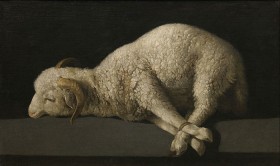A Conversation with Rachel Heuberger on the Biblical Story of the Binding of Isaac and the Exhibition “Obedience”
The exhibition “Obedience. An Installation in 15 Rooms by Saskia Boddeke & Peter Greenaway” has been open for some time now at the Jewish Museum Berlin. As with every exhibition, this one meets the approval of our visitors to various degrees. Unlike other exhibitions however, the feedback – which often reaches us later – is different than what we might have anticipated. Indeed, this was the case with Dr. Rachel Heuberger, the curator of the Hebraica and Judaica collections at the University Library of Frankfurt. We spoke right after her visit about her thoughts and impressions.
Mirjam Wenzel: You just saw the exhibition “Obedience” by Saskia Boddeke and Peter Greenaway. How would you describe it?
Rachel Heuberger: The exhibition appealed to me on a very emotional level. I know the subject matter well, too. From the start I was touched and sometimes even agitated, especially by the ballet and music, which stayed in my ear for a long time. I had a sense of being addressed directly. The unusual presentation featured parts throughout that provoked contradictory, even hostile reactions in me. But I was never disengaged. I find that very remarkable for an exhibition.
Thank you for the compliment. You picked up on exactly what Saskia Boddeke and Peter Greenaway had in mind: to present visitors with a sensory, emotional experience. Was there any item, a work of art or a film, that particularly spoke to you or captured your imagination?
I was very impressed by the room with the video in which “the devil” tries to talk Abraham into doubting God’s command. He uses a striking range of human expressiveness to persuade Abraham to refuse to do the deed, to strengthen his inner conflict about such an act, and to place his natural feelings of love for his son before his loyalty to God. But you really need to watch the entire video in peace and quiet, and give it time to affect you.
Peace and quiet is definitely something that goes hand in hand with a visit, and even more so with an immersion into the Hebraica and Judaica collection at the University Library of Frankfurt am Main – the collection you curate! What role does the story of the binding of Isaac (Moses 1.22) play in the collection?
The Hebraica and Judaica collection of the University Library of Frankfurt am Main holds the largest collection of literature on Judaism, in all its facets and forms, in Germany. The subject is obviously part of our comprehensive holdings. These include various editions of the Bible in the original as well as in translation, along with handwritten and ancient prints on Biblical topics. We also have all the commentaries and different exegeses from both Jewish and anti-Jewish perspectives, representing every century up to our own.
Dance scene from Club Guy & Roni in the installation “Obedience”, Luperpedia Foundation.
Beside the extraordinary texts at the Frankfurt collection, were there other thoughts, images, or texts that you associated with this Biblical story?
Abraham’s willingness to give up everything else for his faith, or to put it in more modern terms, for his conviction, was always the central element for me. I’ve never doubted that the Biblical narrative would come to a ‘good end’ or thought it could turn out differently. The text isn’t really about blind obedience out of fear. It’s about how Abraham is ready to do this deed because he has chosen this path and this faith himself, so he has a deep sense of trust that this is the right thing.

Francisco de Zurbarán, Agnus Dei, 1635-1640. Video mapping on repro
© Madrid, Museo Nacional del Prado
Given that you’ve read the Biblical story until now as narrative about trusting God, did your visit to the exhibition add another perspective?
I found it interesting to juxtapose the Jewish tradition with Christianity and Islam. It’s interesting the way Islam deals with Ismael’s story and how relevant that is. And the historical works that portray the crucifixion of Jesus with direct references to the sacrifice of Isaac especially showed me how differently Judaism and Christianity interpret the end of the story. Considering that we’re still living in the ‘post-‘ period, in the end of the story Isaac and Ismael are not sacrificed but saved, while Jesus is sacrificed. I’ll certainly continue to ponder the past and current impacts of these varying interpretations.
Rachel Heuberger spoke with Mirjam Wenzel, media, at the end of a long, eventful summer day.

